The McKinnon Jet Goose
by Burke Mees
Published 14 May 2024; Updated 11 Jul 2024
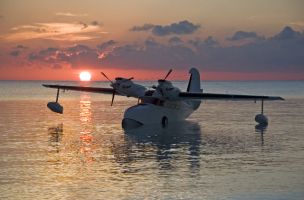
The McKinnon G21C
(image courtesy of Aerometal International, Inc.) |
Until recently I’ve never paid much attention to the McKinnon G21G Turbine Goose. That airplane has a lot of history in Coastal Alaska, but that was before my time. In fact it was just barely before my time. When Alaska’s last commercially operated Turbine Goose disappeared in 1996, I was hired to replace the missing pilot, so my career in the piston Goose began at the exact moment that the era of the turbine version came to an end. As far as I was concerned, the Turbine Goose was like the Steller Sea Cow–just another extinct creature from an earlier epoch in that primordial Aleutian landscape of steaming volcanoes.
Another reason I never gave much thought to the Turbine Goose is that I just don’t get excited about turbine conversions. A well-designed airplane is a complete package, where all the parts and pieces are engineered to work with each other, and changing a component as fundamental as the engine usually disrupts the natural balance of everything else. The original Goose is one of those airplanes they got right from the beginning and I wasn’t particularly interested in anybody’s attempt to change it. |
At least that’s how I thought of the Turbine Goose, if I thought of it at all, which really I didn’t. But that changed when I met Doug DeVries. He was in the final stages of a ten-year rebuild and asked if I’d help him with the first flights and training. Of course I accepted, and I was excited about it. I was looking forward to something new but I had no idea of how much I’d like it. Sometimes you don’t know what you’re missing until you stumble onto it, and the Turbine Goose has since made the short list of my all-time favorite airplanes. It’s definitely an airplane worth writing about.
What Is It?
The turbine Goose has a personality that spans 80 years of aviation history. The vintage airframe is straight out of the1930s, the long slender turbine engine nacelles are reminiscent of the early Jet age, and it has enough satellite technology in the panel to give it 21st century credentials. Leroy Grumman probably wouldn’t know what to think of it all.
This is more than just a modified Grumman G21A, it’s actually a McKinnon G21C which has been further modified by a one-time STC to the G21G configuration and falls under an entirely different type certificate. Many of the features remain the same, such as the original hand-crank landing gear. Other things have changed, such as a bleed air heat system in place of the old exhaust heat exchanger.
In the weeks leading up to the first flight, I spent a lot of time learning the details of this airplane and working with Doug to develop procedures for it. Larry Teufel, who owns the only other currently flying Turbine Goose was a lot of help here, including generously offering me a flight in his plane.
McKinnon G21G Turbine Goose
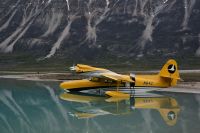 |
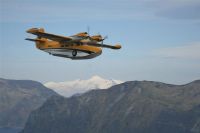 |
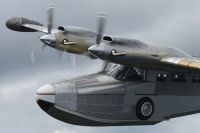 |
 |
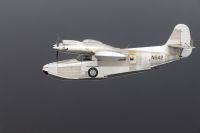 |
| (Burke Mees) |
(Doug DeVriest) |
(Jim Schoeggl) |
(Jim Schoeggl) |
(Judah Wong) |
First Flight
The first flight after a ten-year rebuild is not a small event and Doug had put together a characteristically thorough shakedown program. We would start with a brief flight to methodically explore the flight characteristic before returning to the runway, complete with a chase-plane. All in all, it was to be a choreographed event, but shortly after we got in the air all that went out the window.
Once airborne it quickly became apparent that there was no mystery here. Not only is this strange looking airplane just a Goose, but it is a darn good Goose. It was flying well and it had the comfortable feel of an old glove. At that point the much-anticipated first flight just turned into a leisurely afternoon outing. We fell into position on the wing of the chase plane to get some photos, then we went completely off-script, heading towards the water to properly baptize this new airplane.
After some water landings on Lake Washington, we went back to Paine Field and by that time an un-forecast quartering wind was gusting to 34 knots. By then the airplane was feeling like an old friend and a little wind hardly mattered. The Goose handled the wind so well that after the first landing we taxied back and did two more turns around the pattern just for fun. The first flight had been a complete success.
That broke the ice and in the weeks that followed I continued to fly the airplane with Doug. There’s nothing like instructing to get to know an airplane, so in the course of Doug’s checkout we were both learning its finer points. The more time I spent in it the more I liked it.
Power, Weight And Speed
Let’s admit it, the main theme of this airplane is power. In measurable terms, the original airplane’s Wasp Junior produces 450 horsepower. The PT6-28 on Doug’s plane produces 680 horsepower, but if you include some jet thrust from the exhaust, that brings the total equivalent shaft horsepower to 715.
But the comparison isn’t just about numbers, there are also different kinds of power. The radial engine exudes the visceral power of internal combustion that produces the satisfying low rumble of reciprocating metal. The turbine engine is a compact crucible of plasma fury, a self-contained blast furnace that feeds the kind of raging inferno you normally find on the surface of the sun. This is power that permeates your clothes with an oily residue of burnt kerosene and leaves the gritty feel of fine soot on your skin. This is the smell of napalm in the morning.
The power of the turbine Goose is impressive, but in the end, power is illusory. No matter how much of it you have, you can always load the airplane until the performance comes back into the normal range, at which point you’re back to where you started. In this case, increasing the gross weight to 12,499 pounds does the job. That’s a 4,500 pound increase over the airplane’s original gross weight.
The empty weight of Doug’s airplane is about what you see in a slightly heavy piston Goose, which means this airplane has an impressively large gross weight envelope. It’s important to point out that two completely different airplanes reside at the opposite ends of this envelope. At light weights the thick wing handles well and the Turbine Goose flies like the proverbial cub. At heavier weights the power curve shifts forward, everything becomes more sensitive and speed becomes a necessary condition for its good behavior.
At first I thought the cautionary warnings you sometimes get about this airplane were overstated, but then I realized they apply to the heavily loaded version. In that case poor airspeed discipline can start you down the wrong road, leading to the kind of compounding, deteriorating behavior that give high-wing-loaded airplanes a bad name. Of course there’s nothing wrong with the Turbine Goose when it’s heavy, it just demands your attention.
If there’s a piece of practical advice here, it’s not to let the sensitivities of a heavy Turbine Goose can catch you by surprise after you’ve been flying the same airplane at lighter weights. I always conclude a Grumman checkout with a flight in a fully-loaded airplane to show how the airplane handles differently at different weights, and this is an especially important topic in the Turbine Goose.
Flying It
When it comes to flying characteristics, the differences between the piston and turbine Goose can mostly be attributed to two things; turbine lag and engine placement.
The reciprocating power of thePratt & Whitney R-985 is pretty much available on-demand in real-time but the PT6 conveys its power through a free-turbine transmission such that large power changes don’t immediately take effect. This time delay can be a nuisance and it can lead to some awkward moments when it comes to meeting the demands of gusty winds or rough water. It’s an additional variable that figures into the rhythms and timing involved in flying a hull seaplane.
Flying this airplane involves managing your energy to accommodate this turbine lag. For example, you’ll typically fly a powered landing approach to keep the engines ‘spooled up’ to shorten the delay should you need power for normal corrections or a go-around. When landing in gusty conditions, carrying some reserve airspeed into the flare gives you something to work with when quick power inputs aren’t readily available.
Probably the most significant airframe change that came with the McKinnon conversion is moving the engine nacelles farther inboard and canting them outward by five degrees. This brings the engines as close together as possible, leaving the propeller arcs only six inches apart.
On taxi, this narrow engine arrangement leaves you with less available yaw for steering, both on land and on the water. In an airplane that has neither a steerable tailwheel nor a water rudder, differential yaw is an important tool and this airplane has less of it. On the other hand, the outward-pointing engines blow air on the tail to give the G21G more air-rudder authority on taxi than you have in the original version.
In flight, the narrow, vectored thrust line that directs the prop blast over the tail results in annoyingly heavy control pressures on the rudder and elevator. On the other hand this combination provides the ingredients for good single-engine handling. This arrangement reduces yaw and increases rudder authority during single-engine flight to the point that Vmc is not even a consideration. The McKinnon manual denies its very existence, stating only that Vmc is below the stall speed.
Exploring the airplane’s single engine characteristics was on the list, but it wasn’t a priority on the first few flights. I figured it we’d get to it in due time, and we did. The scenario presented itself on the third flight in the form of a short-notice precautionary shutdown.
The Goose On One Engine
We were climbing out from Paine Field through about 3,000 feet when the right engine oil temperature started making a steady climb into the red. Reducing power on that side didn’t change anything so it occurred to me that this would be a good time to see how the plane does on one engine. With the throttle at idle I feathered the propeller and brought the condition lever to cutoff. It was no surprise to anyone that the airplane did just fine.
It was perhaps mostly out of reflex that I declared an emergency with Paine Tower and told them we would return to the airport with an engine shut down. That’s just what you do given the circumstances, but in retrospect the term ‘emergency’ overstated the situation. The remaining engine provided more than enough power, the airplane was handling just fine and we made a leisurely return to the field for an uneventful landing. I did want the priority handling that goes to an emergency aircraft, but really this wasn’t a big deal.
On final approach I advised the tower that, with no tailwheel steering and power on only one side, we would probably be disabled on the runway after landing. At least that’s how it works with the piston Goose, but as usual I had underestimated this airplane. After landing the left engine’s prop blast over the air rudder provided sufficient steerage to clear the runway and make the long taxi back to the hangar under our own power. We were able to make turns in both directions along the way, although at one point I made a left turn by way of a right 270.
The oil overtemp turned out to be an indication problem but it provided us with some real-world single-engine practice. The only noteworthy thing about the single-engine approach and landing is that it was hardly noteworthy. I should put this in context by pointing out that we were light, but subsequent experimentation has shown that this plane can hold its own in single-engine flight at heavier weights as well.
On The Water
By now you’re probably thinking this article is taking an awfully long time to get to the point, which obviously is how this airplane does on the water. The only reason to have an airplane like this is for its water capabilities, otherwise you’d just get a Beechcraft King Air, like everyone else.
As a water plane, the Turbine Goose for the most part retains the good character of the original. It effortlessly does nice landings, it gracefully leans into tight step turns with a wing float planning on the water, it has no porpoising tendencies of any consequence and it generally does what a hull airplane should do.
On the down side, the Turbine Goose shares one of the original version’s main weaknesses, which is propeller spray exposure. Since the beginning, Goose propellers have been located right in the spray zone and you’d think moving them forward with the turbine conversion might help but that’s not the case. In fact the Turbine Goose might even be worse. On takeoff, even in good conditions, it tends to throw so much water on the windshield that you often lose forward visibility for a few seconds while getting on the step. Things aren’t too bad at lighter weights, but heavy-weight takeoffs are seriously abusive to the props.
The Turbine Goose has one of my all-time favorite features; dual reversing propellers. These make some amazing things possible when it comes to maneuvering on the water, such as hovering at a standstill, turning within your own wingspan and backing up. Reverse thrust can also come in handy after a rough water landing to dissipate energy before slamming into the next big wave.
At this point, I should mention that using reverse to decelerate after a runway landing is not always a good idea. With no tailwheel steering, going into reverse on the rollout takes airflow away from the rudder at an inconvenient time. I didn’t address this with Doug but he discovered it on his own. It was apparently a memorable episode but nothing bad came of it. The takeaway is that if you use reverse after a runway landing, you should first transition to steering with the brakes in anticipation of losing the air rudder.
In addition to reverse, the turbine engines make possible another means of maneuvering on the water. For slow, delicate work, such as approaching a dock, you can eliminate propeller thrust altogether by feathering the props and taxi using the jet thrust from the exhaust. This was another insightful tip that was provided by Larry Teufel.
One of the strengths of the original Goose is that it makes an excellent rough water airplane, and that goes for the Turbine version as long as it’s not too heavy. The G21G withstands a good pounding at standard piston Goose weights, but those same conditions seem a little much as you get closer to the new increased gross weight number. Grumman built strong airplanes and I’ve never felt bad about beating them up in rough water, but there’s a limit to what’s appropriate.
Compared to the original Goose, I’d say the G21G makes a better wheelplane, and not quite as good a seaplane, mostly because of the spray issue. In either case, on land or on water, the Turbine Goose has greatly expanded capabilities.
I thoroughly enjoyed my time in the Turbine Goose, but it didn’t take long to accomplish my goal as an instructor, which is to make myself obsolete. Doug caught on quickly, he passed his Multiengine Sea checkride, and before long it was time for me to get out of the way. Everyone ultimately has to finish the process of getting to know an airplane on their own. It had been a pleasure to work with Doug, he has something special with this airplane and it was satisfying to have been a part of it.
This could have been the end of the story but it didn’t turn out that way. Doug made good use of the airplane for a year, during which time it became a common sight throughout the Western states. After a while he started thinking about doing some more serious traveling, and at that point he invited me to join him. What followed were two trips that traversed 167 degrees of longitude. We had gotten to know the airplane, but we didn’t see the full extent of what it can do until we got it out on the road. These trips provided even more to write about, but that is a different story for another time.
Sidebar—Reverse Thrust On The Columbia River
 |
| Beaching Diagram |
Reverse thrust in a twin-engine seaplane is a tool that can be creatively applied to a wide range of situations. To give one example, Doug and I spent some time on the Columbia River, backing the airplane across the current onto beaches while large ships went by in the background. The Columbia River is Larry Teufel’s home turf and he suggested this technique as a way to get ashore on the soft, sandy beaches.
The normal way to beach a Goose is to extend the wheels and drive partially out of the water, but this requires a hard-packed beach that can support weight on the wheels. Using the normal method on a soft river beach results in getting stuck, so backing the airplane tail first onto the beach is a good alternative.
Once we identified a good section of beach, we practiced this maneuver repeatedly until we had refined it into a step-by-step procedure, which is described below and illustrated in the accompanying diagram.
- The first step is to identify a good beach from the air, noting some prominent objects on shore that allow you to locate it when you’re on the water. After landing, extend the wheels, unlock the tailwheel and taxi upstream past the desired beaching spot.
- Turn away from the beach and go into reverse while drifting downstream. Establish a crab against the current to hold position abeam the beaching spot.
- Back the airplane towards the beach adjusting the crab angle to eliminate any drift. Look out the left window to steer towards the desired spot and control approach speed. Occasionally look out the right window for any debris moving with the current. (A log drifting towards the airplane would be a reason to abort the maneuver and get out if its way) Look at whichever wing float is in the water to make sure excessive backwards waterspeed isn’t causing it to dig into the water.
- When the tailwheel contacts the beach, increase the reverse thrust to stick it in the sand. Before shutting down the engines you may want to send someone out the aft cabin door to secure the airplane with a line from the tail.
General Principles For Using Reverse
Beaching is just one useful application of reverse. Following are some general considerations that apply to using reverse in any situation.
- When using reverse remember that for a given torque value the props will produce more thrust in the forward range than in the reverse range. That’s because propeller blades are designed to pull forward and they are less efficient at reverse angles. Keep this in mind as you switch between forward and reverse, anticipating that your inputs will need to be more assertive in the reverse range.
- When using a substantial amount of power in reverse (above idle power), come out of reverse gradually by first easing the power to idle. If you move out of reverse too quickly, the props will move into the forward range while engine power is still above idle and the airplane will lurch forward.
- The time it takes for the props to move in and out of reverse gives us an additional time lag to deal with. The timing of your power inputs should anticipate both the normal turbine lag and also the time it takes for the props to move in and out of reverse.
- Wing floats use a broad, upward-angled bow to raise the wing under forward motion. When moving backwards, the pointed, downward angled stern provides less flotation and may dig into the water. When moving backwards keep an eye on whichever float is in the water. If it starts to dig in, reduce the backwards speed or start moving forward.
Reverse is intended for short duration use and using it for longer periods of time can raise engine temperatures. In the case the PT6, prolonged use of reverse will raise the oil temperature since the oil cooler relies on forward airflow. In the case of piston airplanes, cylinder cooling relies on forward airflow through the cowl so prolonged use of reverse will raise the cylinder head temps. During our extended session of making repeated approaches to the Columbia River beach, we occasionally had to break off the exercise and spend some time taxiing forward to lower the oil temps.






